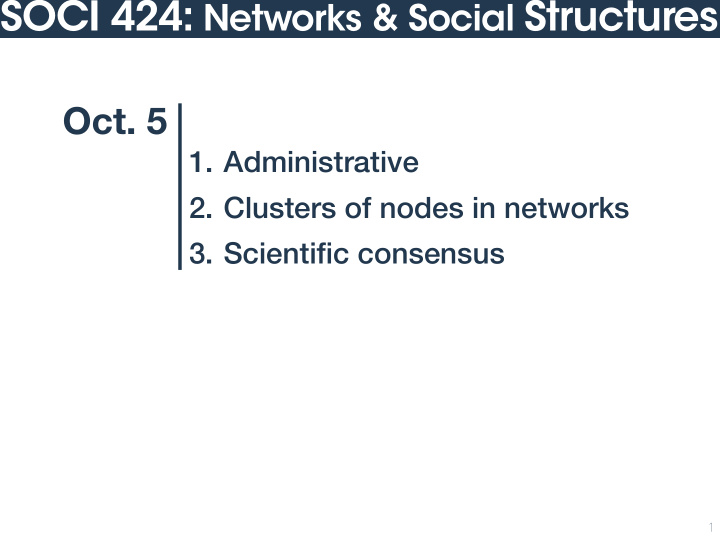



SOCI 424: Networks & Social Structures Oct. 5 1. Administrative 2. Clusters of nodes in networks 3. Scientific consensus 1
Administrative Lab 1 feedback ⦙ Today or tomorrow! Lab 2 ⦙ Posted, due Friday Help sessions ⦙ Thursday 10:30–noon ⦙ One other? 2
Citation Data Clusters of Nodes in Networks 3
Clusters Grouping nodes in networks Why? ⦙ Groups are a basic theoretical component of social structure. ⦙ Cohesion, unity, identity, … ⦙ Divisions, conflict, hierarchy, … How? ⦙ Generally: clusters are groups of nodes that tend to connect more to each other than to others But what does that mean? ⦙ Embedded cliques ⦙ Overlapping/hierarchical groups ⦙ Partition of entire network 4
Clusters Grouping nodes in networks Why? ⦙ Groups are a basic theoretical component of social structure. ⦙ Cohesion, unity, identity, … ⦙ Divisions, conflict, hierarchy, … How? ⦙ Generally: clusters are groups of nodes that tend to connect more to each other than to others But what does that mean? ⦙ Embedded cliques ⦙ Overlapping/hierarchical groups ⦙ Partition of entire network 5
Clusters Grouping nodes in networks Why? ⦙ Groups are a basic theoretical component of social structure. ⦙ Cohesion, unity, identity, … ⦙ Divisions, conflict, hierarchy, … How? ⦙ Generally: clusters are groups of nodes that tend to connect more to each other than to others But what does that mean? ⦙ Embedded cliques ⦙ Overlapping/hierarchical groups ⦙ Partition of entire network 6
Modularity Q = –0.21 Modularity (Q) measures 1 ‘goodness’ of a partitioning 3 ⦙ If you are given a particular 1 partitioning of a network, 2 2 3 modularity measures how much 1 1 3 2 1 edges tend to stay within a 2 1 partition. 1 2 3 ⦙ Ranges from –0.5 (very bad fit) to 3 1.0 (very good fit) 3 Modularity maximization Q = 0.40 ⦙ Clustering strategy that finds the 4 partitioning that has the highest possible modularity 3 2 2 2 2 2 2 1 1 2 1 1 1 1 1 1 1 7
Clustering algorithms A Midsummer Mote Night’s Dream Character network Chorus ⦙ Directed edges First Cobweb Fairy indicate number of times one character’s Pease– blossom Mustard– line immediately seed preceded another’s ⦙ E.g. Cobweb speaks Second Fairy and then Mote speaks Titania Bottom ⦙ Rough proxy for Snout interaction Quince Oberon Flute Puck Starveling Snug Fairy Demetrius Theseus Lysander Helena Hermia Hippolyta Philostrate Egeus 8
Clustering algorithms A Midsummer Mote Night’s Dream Maximum modularity clusters Chorus First Cobweb Fairy ⦙ Q = 0.472 Pease– blossom Mustard– seed Second Fairy Titania Bottom Snout Quince Oberon Flute Puck Starveling Snug Fairy Demetrius Theseus Lysander Helena Hermia Hippolyta Philostrate Egeus 9
Clustering algorithms Maximum mod. Infomap Mote Mote Q = 0.472 Q = 0.447 Chorus Chorus First First Cobweb Cobweb Fairy Fairy Pease– Pease– blossom blossom Mustard– Mustard– seed seed Second Second Fairy Fairy Titania Titania Bottom Bottom Snout Snout Quince Quince Oberon Oberon Flute Flute Puck Puck Starveling Starveling Snug Snug Fairy Fairy Demetrius Demetrius Theseus Theseus Lysander Lysander Helena Helena Hermia Hermia Hippolyta Hippolyta Philostrate Philostrate Egeus Egeus Leading eigenvector Walktrap Mote Mote Q = 0.369 Q = 0.456 Chorus Chorus First First Cobweb Cobweb Fairy Fairy Pease– Pease– blossom blossom Mustard– Mustard– seed seed Second Second Fairy Fairy Titania Titania Bottom Bottom Snout Snout Quince Quince Oberon Oberon Flute Flute Puck Puck Starveling Starveling Snug Snug Fairy Fairy Demetrius Demetrius Theseus Theseus Lysander Lysander Helena Helena Hermia Hermia Hippolyta Hippolyta 10 Philostrate Philostrate Egeus Egeus
Clustering algorithms Maximum mod. Infomap Mote Mote Q = 0.472 Q = 0.447 Chorus Chorus First First Cobweb Cobweb Fairy Fairy Pease– Pease– blossom blossom Mustard– Mustard– seed seed Second Second Fairy Fairy Titania Titania Bottom Bottom Snout Snout Quince Quince Oberon Oberon Flute Flute Puck Puck Starveling Starveling Snug Snug Fairy Fairy Demetrius Demetrius Theseus Theseus Lysander Lysander Helena Helena Hermia Hermia Hippolyta Hippolyta Philostrate Philostrate Egeus Egeus Leading eigenvector Walktrap Mote Mote Q = 0.369 Q = 0.456 Chorus Chorus First First Cobweb Cobweb Fairy Fairy Pease– Pease– blossom blossom Mustard– Mustard– seed seed Second Second Fairy Fairy Titania Titania Bottom Bottom Snout Snout Quince Quince Oberon Oberon Flute Flute Puck Puck Starveling Starveling Snug Snug Fairy Fairy Demetrius Demetrius Theseus Theseus Lysander Lysander Helena Helena Hermia Hermia Hippolyta Hippolyta 11 Philostrate Philostrate Egeus Egeus
Citation Data Scientific Consensus 12
Sociology of science The Temporal Structure of Scientific Consensus Formation Shwed and Bearman (2010) Deep dive into the sociology of science S&B: ⦙ Scientific consensus is contingent on broader societal discourse ⦙ Therefore there is not a uniform progression toward consensus ⦙ S&B investigate this by using citation networks to measure consensus over time 13
Citation networks Measuring relations between scholarly publications Citation network ⦙ Vertices are publications (articles, books, conference papers, etc.) ⦙ Directed edges represent citation ⦙ Temporality imposes structure Citations as relations ⦙ Scientific knowledge is not purely cumulative ⦙ Citation indicates similarity of theories, methods, assumptions, etc. 14
Measuring consensus Two hypothetical citation networks Q = 0.5 Q = 0.05 (epistemic rivalry) (epistemic consensus) 15
Recommend
More recommend